Baselayers are critical clothing for outdoor recreation. Not only do they solve an essential problem — regulating temperature and sweat in the wilderness — but they solve the problem with a heap of features that gear-heads love: unique fabrics, minimal weight, breathability, and odor protection.
They are typically long-sleeve tops and full-length bottoms that are worn directly against the skin. They layer under anything else you might wear, thus the “base” in baselayer. Baselayers are often referred to as long underwear, thermal underwear, or thermal clothing. They all mean basically the same thing.
Technically baselayers work any time of year. Baselayers for scalding environments help keep you protected from the sun and free of sweat. But most people consider baselayers to be the ones that keep you the right degree of warm and sweat-free in cold-to-downright-freezing temperatures. All while maintaining breathability, a noticeable lack of stink, and minimal weight.
This is our Winter Guide to Baselayers, so it focuses on the tops and pants for the coldest months of the year. Advice, categorization, and product picks below.
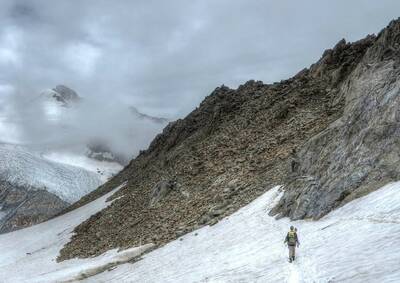
Baselayers required.
Pick the Right Baselayer Fabric Weight for Winter
The first piece of know-how when it comes to baselayers is gauging the “fabric weight.” This is a term that generally refers to the overall weight of a baselayer (rather than the literal weight).There are three general categories of baselayer weight — lightweight, midweight, and heavweight — and that for winter baselayers, you’ll want to stick to the latter two.
Midweight baselayers are the most versatile and popular because they provide decent warmth, aren’t very heavy, and breathe excepetionally. Most brands include the fabric weight in the name of the baselayer, like Patagonia Midweight Capilene.
Heavyweight baselayers are for anyone who runs really cold, wants a layer that provides more warmth than breathability, or doesn’t want a very active baselayer.
Keep in mind that baselayers are meant to be worn continuously, so if you get a heavyweight layer don’t expect to hike uphill for hours and remain sweat-free. A midweight baselayer will give you enough warmth when a biting cold comes, but will get you through that hike with a lot less sweat.
Finally, remember that a baselayer is not your entire system of warmth — it is the first layer in the system. A midlayer often provides most of the warmth, whether it be a fleece, vest, or down jacket.
Baselayer Fabrics
The second main consideration for baselayers is what they’re made of — you generally choose between a natural fiber and a synthetic one.
Merino wool is the most common natural fiber used in baselayers, and polyester is the most common synthetic fiber.
There are pros and cons to both, and in the end each brand has a different manufacturing technique, so not all merino or synthetic baselayers are the exact same.
That said, here are the key traits of each:
Merino baselayers are warmer, regulate temperature better, wick sweat better, require less washing and have better odor control. That said, they don’t last as long as synthetics, take way longer to dry when soaked, and are more expensive. (They also itch a small percentage of the population, though it’s nothing like wool used to be.)
Synthetic baselayers are quite durable, they dry very quickly, they can be washed easily, and they repel water. But they’re not nearly as warm as wool, can get quite stinky even with regular washing, don’t regulate your temperature as well, and are made of synthetic materials (obviously), so they’re not a natural product.
Brands today are blending wool and synthetic fabrics together to make baselayers that have the best of both worlds. These blended fabrics shine for wicking sweat and letting your body breathe, so are often the best for people who want a very active baselayer.
Tried and True Synthetic Baselayers for Winter
Below are some of our favorite synthetic base layers. Note that we prefer to buy baselayers in sets (top and bottoms), because once you find a fit and fabric type you like best, you tend want to cover yourself in it!
REI Co-Op Midweight Base Layer Crew Top – $49.95
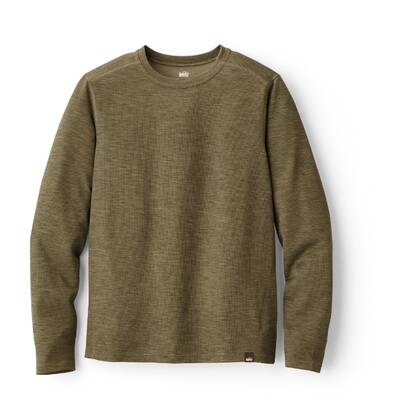
The REI Co-Op Midweight Base Layer Crew is the epitome of an average-priced, well-built, synthetic baselayer. It’s made of bluesign approved polyester, has a UPF-50 rating to help block sun, and fits squarely in the “midweight” category, meaning it will provide decent warmth and breathability.
The Midweight Crew Top uses a 4-way stretch polyester fabric and shoulder seams that are rolled forward, two active-oriented features that help range of movement and durability when wearing a backpack.
The crew cut for men and women, styled to be semi-athletic in fit, allows you to wear it is a technical (if simple) baselayer while backpacking, skiing, or mountaineering. That said, it works just as well as a warm long-sleeve around town.
The sub-$50 price tag (often on sale, too), makes this a no-brainer for anyone who wants a do-it-all affordable synthetic base layer.
See Women's REI Midweight Base Layer Crew Top See Men's REI Midweight Crew Base Layer TopREI Co-Op Midweight Base Layer Bottoms – $49.95
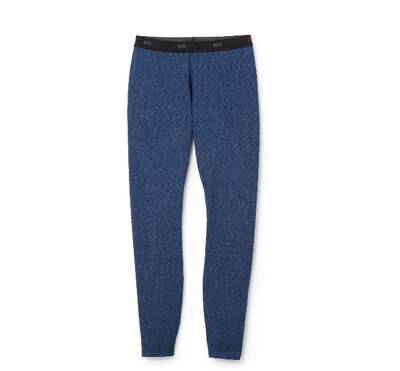
Much like the Crew Top above, the REI Midweight Base Layer Bottoms embody affordable, multi-functional synthetic long underwear. They are made in a wide range of sizes for men and women, and utilize the same bluesign approved polyester, meaning they are better for than environment than most synthetic layers.
While the Bottoms are categorized as “midweight,” they are thin enough to layer under any kind of pants — jeans, ski pants, or hiking pants — and provide exceptional warmth.
See Women's REI Midweight Base Layer Bottoms See Men's REI Midweight Base Layer BottomsPatagonia Capilene Thermal Weight Zip Neck – $99
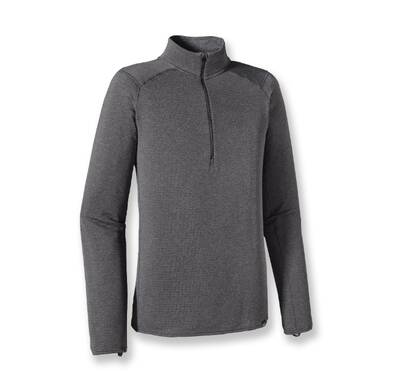
Patagonia is one of the brands that helped introduce the concept of layering to the outdoor community, and they also pioneered the synthetic material movement back in the ‘70’s. The Capilene line has stood the test of time, and we love the Patagonia Capilene Thermal Weight with a Zippered Neck.
This piece, for men and women, is a fully synthetic, heavyweight, technical baselayer top.
The technical aspects include thumb-hole loops for quick layering, the zipper, which allows you to vent heat when moving fast, and the very athletic fit.
Patagonia uses the term “thermal” to mean heavyweight when it comes to fabric weight — the Capilene Thermal Weight uses Polartec Power Grid fabric (bluesign approved), which looks like small squares laid out in a grid. This provides plenty of warmth from the thick squares, but allows surprising breathability in the thin lines between the squares.
This is a standout piece for a synthetic base layer, to the point where it can be used in almost any environment.
See Women's Patagonia Capilene Thermal Zip See Men's Patagonia Capilene Thermal ZipPatagonia Capilene Thermal Weight Bottoms – $89
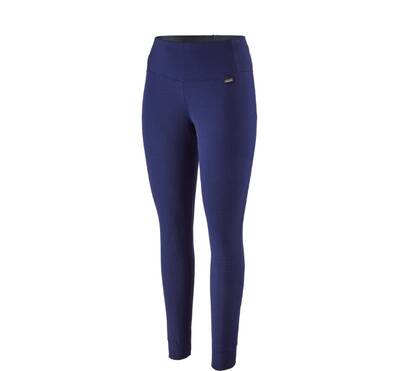
In line with the Zip Neck top above, the Patagonia Capilene Thermal Weight Bottoms use a heavyweight fabric to provide excellent warmth, yet maintain some breathability when moving.
The Capilene line uses Polygiene, which is helps control odor, and is made mostly of recycled materials. The Bottoms by Patagonia are known for an athletic fit that’s correctly gusseted around the crotch for both men and women, and an ultra-comfy elastic band.
These use the same grid-pattern as the tops, and are some of the best synthetic base layer bottoms you can buy.
See Women's Patagonia Capilene Thermal Bottoms See Men's Patagonia Capilene Thermal BottomsOdlo Performance Blackcomb Base Layer Shirt with Face Mask – $110
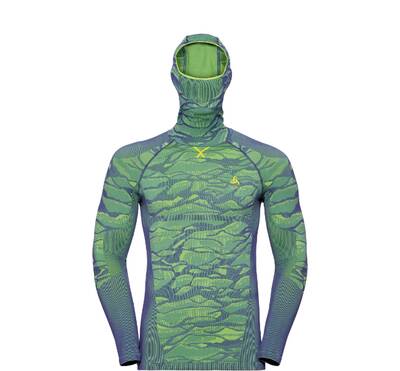
Odlo is a Norwegian brand founded in 1946, which made its mark on the Olympic speed skating world by developing synthetic suits that allowed athletes to thrive in an exhaustive, icy sport. In short, the perfect training ground for a solid baselayer.
If you need a technical base layer above all else, check out the Odlo Performance Blackcomb line. The Base Layer Shirt with Face Mask provides full coverage, including a balaclava-style hood, to keep your neck and head warm with the rest of your torso. The full coverage keeps you warm, but the Blackcomb Bae Layer Shirt really shines when it comes to breathability — you can run with the hood on.
The Blackcomb line is made with seamless body-mapping technology, a method of production that has become more popular in recent years. This means less chafing (seams typically chafe), and a more fluid fit for high-ouput activities.
If you’re into the style, and want a truly technical midweight synthetic baselayer, the Odlo Performance Blackcomb is an excellent, if expensive, choice.
See Women's Odlo Performance Blackcomb Base Layer Shirt with Face Mask See Men's Odlo Performance Blackcomb Base Layer Shirt with Face MaskOdlo Performance Blackcomb Base Layer Pants – $90
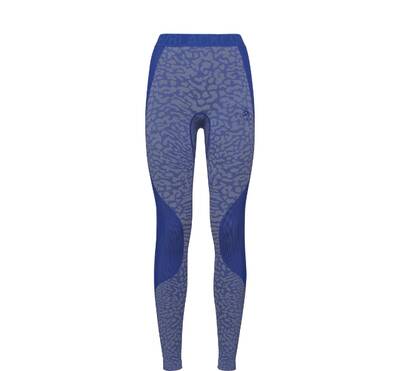
If the Odlo shirt is your thing, pick up the Performance Blackcomb Base Layer pants as well. They use the same impressive body-mapping technology, which makes for well-fitting pants that move when you move.
The Blackcomb Base Layer Pants are made out of a recycled PES fabric, which is a combination of polyamide, polyester, and elastane, all known for stretch and breathability.
With these pants and the Odlo shirt above, you will be covered for any cold-weather high-output activities.
See Women's Odlo Performance Blackcomb Base Layer Pants See Men's Odlo Performance Blackcomb Base Layer PantsTried and True Merino Wool Baselayers for Winter
Below are some of our favorite merino wool (and blended) base layers. Remember that we prefer to buy baselayers in sets (top and bottoms), because once you find a fit and fabric type you like best, you tend want to cover yourself in it!
Smartwool Merino 250 Base Layer Crew Top – $100

If there was a single, go-to merino wool baselayer we could recommend, it would be the Smartwool Merino 250 Base Layer Crew Top. It’s a classic because it performs well for technical or casual environments, is made of Smartwool’s impressive merino wool, has a fit that works for most people, and manages to hit the perfect mark between resting warmth and active breathability.
While there are more technical Smartwool pieces, the Base Layer Crew Top can basically be worn like a long-sleeve t-shirt — but you can do that in a brewery, while camping, or on an alpine peak. The merino wool doesn’t stink even after days of use, but it’s also quite durable, and Smartwool has ensured you can machine wash the piece easily.
The Smartwool Merino 250 Base Layer is that thin, midweight baeselayer that fits under anything and works for any scenario. The only real drawback is cost — as you’ll see, wool baselayers are more expensive. Look for it on sale!
See Women's Smartwool Merino 250 Base Layer Crew Top See Men's Smartwool Merino 250 Base Layer Crew TopSmartwool Merino 250 Base Layer Bottoms – $100
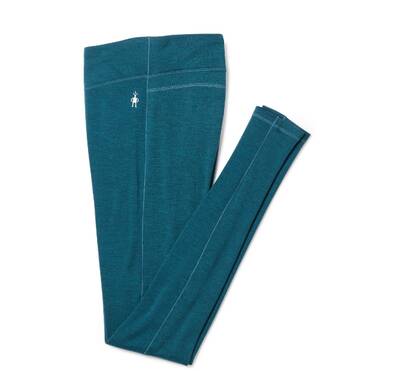
Baselayer bottoms don’t typically take as much abuse as tops — you either wear a layer over them, and no pack straps sit on the shoulders — so you mainly need them to stretch, fit well, keep you warm, and last.
Smartwool hits each of these marks with the Merino 250 Base Layer bottoms, which have recently been updated for improved the fit. The waistband doesn’t roll down, and the elastic is covered in merino wool for warmth and next-to-skin comfort. They provide plenty of warmth, too.
For men, there’s an easy-to-use fly, and for women these pants can be used as a cold-weather yoga layer.
See Women's Smartwool Merino 250 Base Layer Bottoms See Men's Smartwool Merino 250 Base Layer BottomsKari Traa Lokke Base Layer Crew Top – $110
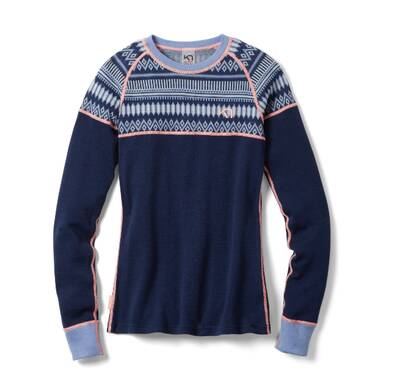
Not every baselayer has to look like a ski-suit or a basic long-sleeve shirt. It is possible to create a stylish baselayer, and Kari Traa has done this with the Lokke Base Layer Crew Top. While it’s only available for women, we find it to be a good example of what’s possible in the casual baselayer market.
The Kari Traa Lokke is a nord-inspired design made of merino wool. It fits close to the skin, but because it’s so warm, it functions as a light sweater, too. There are reports of the Lokke running a bit small across the chest, so make sure to order a size up if necessary.
See Women's Kari Traa Lokke Base Layer Crew TopREI Co-Op Midweight Merino Layer Half-Zip Top – $89.50
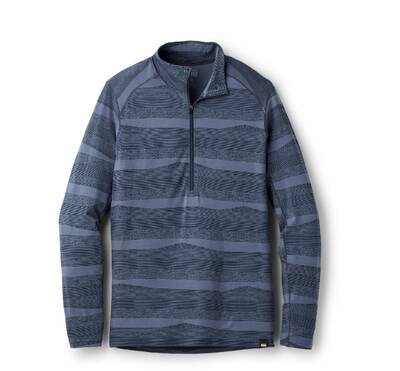
If you love REI, but want the merino wool treatment, the Midweight Merino Layer Half-Zip is a standout. It’s a bit cheaper than the competition, often on sale, and is made with more active pursuits in mind.
The zipper goes down to your chest, which makes this single layer incredibly breathable. Wear it on crisp mornings while backpacking, then, as the sun begins to beat down, unzip the top to truly vent your sweat. The neckline on the Midweight Merino Layer is also quite tall, which gives you a chin guard when things get chilly and windy.
The 200-gram fine merino wool doesn’t itch, is machine washable, and does what wool does best: breathable warmth.
See Women's REI Midweight Merino Half-Zip Top See Men's REI Midweight Merino Half-Zip TopPatagonia Capilene Air Base Layer Top – $129
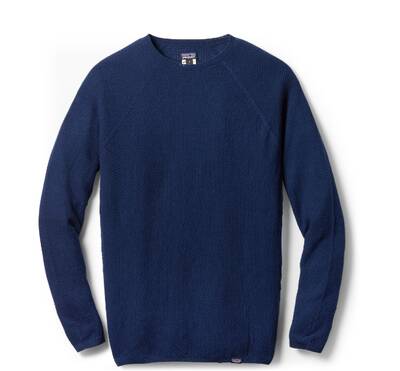
The final baselayer on this list is one of the most unique. Patagonia’s Capilene Air Base Layers use a blended fabric, which is part 51% responsibly-sourced merino wool and 49% recycled polyester. Patagonia uses a 3-D knit structure to create a seamless top, which means the range of motion and comfort is as good as it gets.
Despite being incredibly light, the Capilene Air Base Layer Top is actually a heavyweight baselayer, and provides an impressive amount of warmth. They do this by airblasting the yarn, which creates more loft than your typical baselayer. That extra loft provides extra warmth.
We love the regular Capilene Air Base Layer Top, as it works on the literal summit point of any mountain, and can be worn to a cold day in the office. The downside is cost: the Capilene Air line is one of the most expensive baselayers you can find.
See Women's Patagonia Capilene Air Base Layer Top See Men's Patagonia Capilene Air Base Layer TopPatagonia Capilene Air Base Layer Bottoms – $129
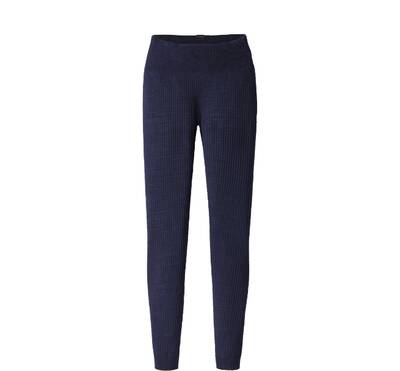
Finally, like the Top above, the Patagonia Capilene Air Base Layer Bottoms are a testament to unique manufacturing that creates ultra-comfortable, incredibly versatile clothing. Made of the same mix of wool and polyester, with the same airblasting technique, the Air Base Layer Bottoms are super warm, surprisingly breathable, and do not stink.
Because they are so light — 5-7 ounces depending on size and gender — these are some of the best bottom layers you can buy. They shrug off sweat like nothing, don’t retain stink, and don’t make much of a dent in your pack.
See Women's Patagonia Capilene Air Base Layer Bottoms See Men's Patagonia Capilene Air Base Layer BottomsThis article is sponsored by REI.
Backpackers.com Affiliate Policy: This guide contains affiliate links, which help fund our website. When you click on the links to purchase the gear we get a commission, and this goes a long way to creating guides, gear reviews, and other excellent content.
Featured image by Helmut Liebelt via Unsplash
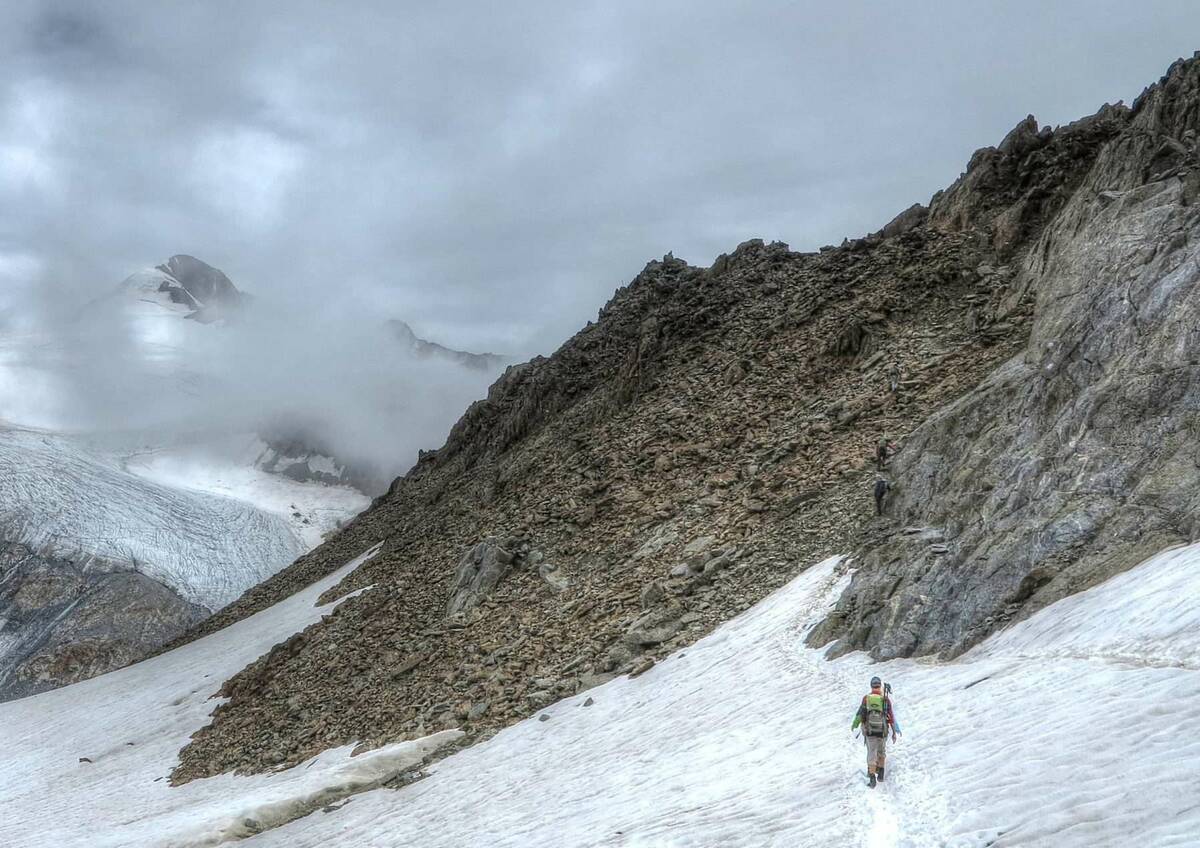
Really off base(layer) w/this article. The absolutely best baselayer I’ve ever used (and many Antarctic Expeditions too) is the Brynje FISHNET in either synthetic or wool blend. The many HOLES in fishnet trap air pockets when a windshirt is worn over & thus provides exceptional warmth w/minimal clothing in temps at freezing. But when climbing hills, FISHNET won’t trap sweat like tight-weave fabrics & fishnet can be fully vented in an instant. It also dries immediately since it’s mostly holes. Can also be worn under a rain jacket to keep the nylon off bare skin.
Hi Dan,
Thanks for reading and commenting! We’ll be sure to check out Brynje baselayers. Sounds like they have a great system.
Curious to see what y’all think about the new Patagonia R1 Air jacket?
Hi Bob,
Thanks for reading and asking! I’m guessing you mean the Patagonia R1 Air Fleece that was debuted a couple weeks ago? We’re excited. We haven’t used it yet, but plan to when reviewing our fleece category.
Technically the fleece is not a baselayer, but we’re guessing it will make a fantastic midlayer that is both cozy and breathable.
What do you think of Kora Yak Wool baselayers?
Also what about Icebreaker’s excellent baselaers?
Thanks for the questions Todd! Kora Yak Wool baselayers are very interseting, and we love seeing a new type of material used to jumpstart an age-old category. We’ll be testing some this year.
Icebreaker is excellent. We find them most comparable to Smartwool in terms of fit and accessibility.